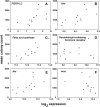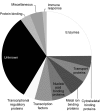Age-specific variation in immune response in Drosophila melanogaster has a genetic basis
- PMID: 22554890
- PMCID: PMC3389989
- DOI: 10.1534/genetics.112.140640
Age-specific variation in immune response in Drosophila melanogaster has a genetic basis
Abstract
Immunosenescence, the age-related decline in immune system function, is a general hallmark of aging. While much is known about the cellular and physiological changes that accompany immunosenescence, we know little about the genetic influences on this phenomenon. In this study we combined age-specific measurements of bacterial clearance ability following infection with whole-genome measurements of the transcriptional response to infection and wounding to identify genes that contribute to the natural variation in immunosenescence, using Drosophila melanogaster as a model system. Twenty inbred lines derived from nature were measured for their ability to clear an Escherichia coli infection at 1 and 4 weeks of age. We used microarrays to simultaneously determine genome-wide expression profiles in infected and wounded flies at each age for 12 of these lines. Lines exhibited significant genetically based variation in bacterial clearance at both ages; however, the genetic basis of this variation changed dramatically with age. Variation in gene expression was significantly correlated with bacterial clearance ability only in the older age group. At 4 weeks of age variation in the expression of 247 genes following infection was associated with genetic variation in bacterial clearance. Functional annotation analyses implicate genes involved in energy metabolism including those in the insulin signaling/TOR pathway as having significant associations with bacterial clearance in older individuals. Given the evolutionary conservation of the genes involved in energy metabolism, our results could have important implications for understanding immunosenescence in other organisms, including humans.
Figures



Similar articles
-
Naturally occurring genetic variation in the age-specific immune response of Drosophila melanogaster.Aging Cell. 2006 Aug;5(4):293-5. doi: 10.1111/j.1474-9726.2006.00219.x. Epub 2006 Jun 27. Aging Cell. 2006. PMID: 16803580
-
Phagocytic ability declines with age in adult Drosophila hemocytes.Aging Cell. 2014 Aug;13(4):719-28. doi: 10.1111/acel.12227. Epub 2014 May 14. Aging Cell. 2014. PMID: 24828474 Free PMC article.
-
Unraveling the Molecular Mechanism of Immunosenescence in Drosophila.Int J Mol Sci. 2018 Aug 21;19(9):2472. doi: 10.3390/ijms19092472. Int J Mol Sci. 2018. PMID: 30134574 Free PMC article. Review.
-
Innate immune responses of Drosophila melanogaster are altered by spaceflight.PLoS One. 2011 Jan 11;6(1):e15361. doi: 10.1371/journal.pone.0015361. PLoS One. 2011. PMID: 21264297 Free PMC article.
-
Immunity and aging: the enemy within?Aging Cell. 2004 Aug;3(4):195-208. doi: 10.1111/j.1474-9728.2004.00106.x. Aging Cell. 2004. PMID: 15268753 Review.
Cited by
-
Inhibition of S6K lowers age-related inflammation and increases lifespan through the endolysosomal system.Nat Aging. 2024 Apr;4(4):491-509. doi: 10.1038/s43587-024-00578-3. Epub 2024 Feb 27. Nat Aging. 2024. PMID: 38413780 Free PMC article.
-
Can disease resistance evolve independently at different ages? Genetic variation in age-dependent resistance to disease in three wild plant species.J Ecol. 2022 Sep;110(9):2046-2061. doi: 10.1111/1365-2745.13966. Epub 2022 Aug 4. J Ecol. 2022. PMID: 36250132 Free PMC article.
-
Genetic determinants of susceptibility to silver nanoparticle-induced acute lung inflammation in mice.FASEB J. 2017 Oct;31(10):4600-4611. doi: 10.1096/fj.201700187R. Epub 2017 Jul 17. FASEB J. 2017. PMID: 28716969 Free PMC article.
-
Transgenerational interactions involving parental age and immune status affect female reproductive success in Drosophila melanogaster.Proc Biol Sci. 2014 Nov 7;281(1794):20141242. doi: 10.1098/rspb.2014.1242. Proc Biol Sci. 2014. PMID: 25253454 Free PMC article.
-
Heuristic-enabled active machine learning: A case study of predicting essential developmental stage and immune response genes in Drosophila melanogaster.PLoS One. 2023 Aug 9;18(8):e0288023. doi: 10.1371/journal.pone.0288023. eCollection 2023. PLoS One. 2023. PMID: 37556452 Free PMC article.
References
-
- Agaisse H., 2008. Investigating the involvement of host factors involved in intracellular pathogen infection by RNAi in Drosophila cells. Methods Mol. Biol. 415: 395–402 - PubMed
-
- Agarwal S., Busse P. J.2010. Innate and adaptive immunosenescence. Ann. Allergy Asthma Immunol. 104:183–190; quiz 190–182, 210.
-
- Agrawal A., Agrawal S., Cao J. N., Su H., Osann K., et al. , 2007. Altered innate immune functioning of dendritic cells in elderly humans: a role of phosphoinositide 3-kinase-signaling pathway. J. Immunol. 178: 6912–6922 - PubMed
-
- Alcaide M., Edwards S. V., 2011. Molecular evolution of the toll-like receptor multigene family in birds. Mol. Biol. Evol. 28: 1703–1715 - PubMed
Publication types
MeSH terms
Grants and funding
LinkOut - more resources
Full Text Sources
Medical
Molecular Biology Databases

